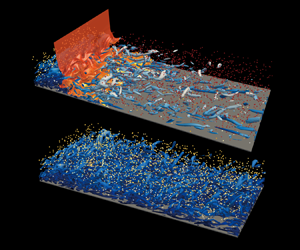Article contents
Two-way coupled turbulent particle-laden boundary layer combustion over a flat plate
Published online by Cambridge University Press: 06 September 2022
Abstract

In the present study, turbulent particle-laden boundary layer combustion over a flat plate is investigated using direct numerical simulation (DNS). A two-way coupled Eulerian–Lagrangian point particle method is used for the solid phase. The effects of particle Stokes numbers, mass loadings and chemical reactions on the interactions between particles and boundary layer turbulence in the near-wall region are explored. It was found that particle heat transfer is dominant over wall heat transfer in the reacting case with heavy particles and large mass loadings, resulting in a lower fluid temperature. Particle accumulation due to the turbophoresis effect in the near-wall region is observed, which is more prominent in the cases with a large Stokes number. The turbophoresis effect is examined via the magnitude of streamwise vorticity  $\varOmega _x$. It is shown that
$\varOmega _x$. It is shown that  $\varOmega _x$ is attenuated by heavy particles, and the attenuation increases with increasing mass loadings. Therefore, particle wall–accumulation is less prominent in the cases with large mass loadings. Compared with the non-reacting cases, the distribution of particles is more inhomogeneous for the reacting cases, where the particles move faster due to intense reactions with increasing wall-normal distance. Finally, the flow topologies and the Reynolds stress anisotropy are examined to understand turbulence modulation by combustion and particles. It was suggested that light particles augment the vortex-dominant topologies, whereas heavy particles have an opposite effect. The anisotropy mapping of the Reynolds stress shows that the flows become more one-dimensional in the near-wall region for the cases with combustion and/or large mass loadings.
$\varOmega _x$ is attenuated by heavy particles, and the attenuation increases with increasing mass loadings. Therefore, particle wall–accumulation is less prominent in the cases with large mass loadings. Compared with the non-reacting cases, the distribution of particles is more inhomogeneous for the reacting cases, where the particles move faster due to intense reactions with increasing wall-normal distance. Finally, the flow topologies and the Reynolds stress anisotropy are examined to understand turbulence modulation by combustion and particles. It was suggested that light particles augment the vortex-dominant topologies, whereas heavy particles have an opposite effect. The anisotropy mapping of the Reynolds stress shows that the flows become more one-dimensional in the near-wall region for the cases with combustion and/or large mass loadings.
- Type
- JFM Papers
- Information
- Copyright
- © The Author(s), 2022. Published by Cambridge University Press
References
REFERENCES
- 8
- Cited by





